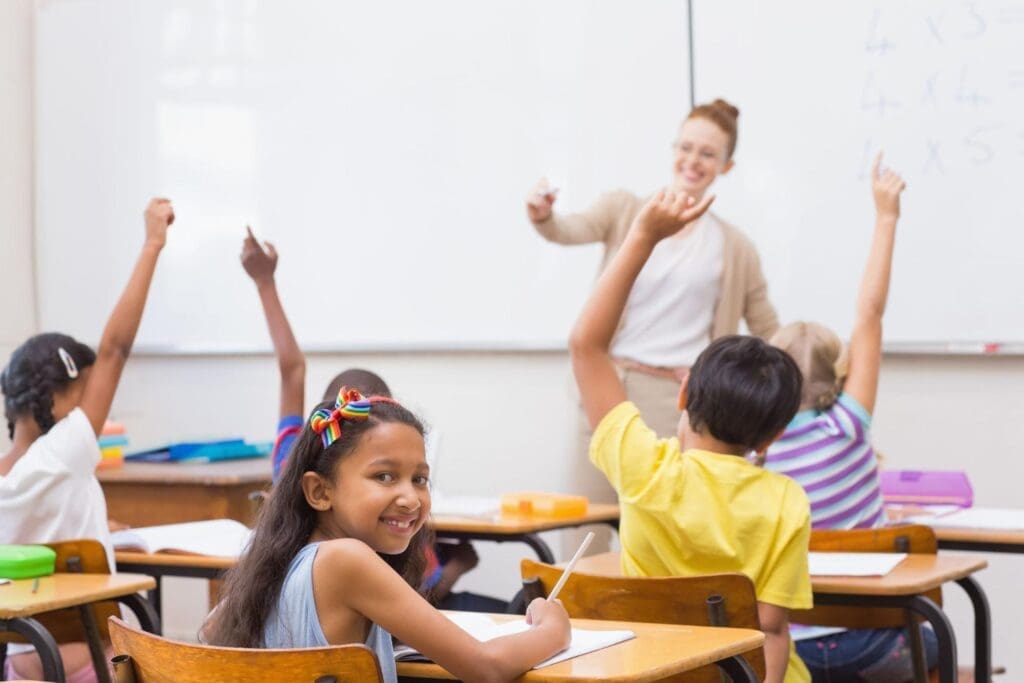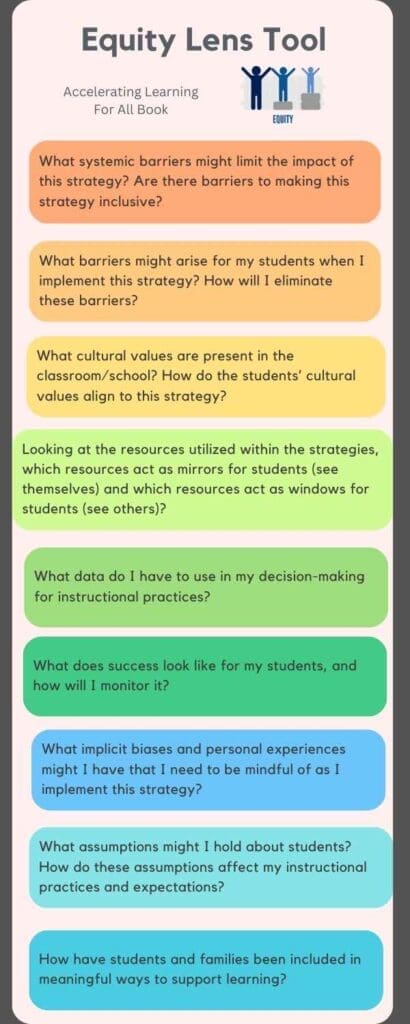
Student Discussion
Student discussion refers to the cognitive process in which students engage in critical thinking by posing and investigating questions, making connections between information and their personal experiences and cultural background, substantiating their reasoning, and questioning their own and others’ perspectives to achieve clarity and comprehension. This definition is provided by authors Rebecca McKinney and Colleen Urlik in their book “Accelerating For ALL Equity in Action.” Educators must teach students the positive habits of discussion as classroom norms, both for whole group and small group discussions.
McKinney and Urlik argue that using tactics like student discussion can enhance an educator’s cultural competency. This involves acknowledging both students and oneself as cultural beings, and utilizing this awareness to facilitate personal and academic development.
“We must know who our students are and seek to understand their lived experiences.”
Incorporating student input into the classroom or school environment is crucial for fostering a classroom culture that values diversity and promotes enhanced learning outcomes for all students.
Student Discussion Expectations
Educators initiate the process of establishing discussion expectations by employing a methodical approach that involves starting with standards and subsequently cultivating the desired norms and constructive patterns of discourse. The Common Core State Standards for Listening and Speaking can provide a basis for establishing expectations for discussions. McKinney and Urlik present an illustration that demonstrates the use of Common Core State Standards (CCSS) speaking and listening criteria for second-grade students. The emphasis is placed on the Comprehension and Collaboration criteria within the Speaking and Listening standards. Authors provide a second grade example of CCSS speaking and listening criteria:
CCSS.ELA-Literacy.SL.2.1.A: Follow agreed-upon rules for discussions (e.g. gaining the floor in respectful ways, listening to others with care, speaking one at a time about the topics and texts under discussion).
CCSS.ELA-Literacy.SL.2.1B: Build on others’ talk in conversations by linking their comments to remarks of others.
CCSS.ELA-Literacy.SL.2.2C: Ask for clarification and further explanation as needed about the topic and text under discussion.
CCSS.ELA-Literacy.SL.2.2: Recount or describe key ideas or details from a read aloud or information presented orally or through other media.
CCSS.ELA-Literacy.SL.2.3: Ask and answer questions about what a speaker says, in order to clarify comprehension, gather additional information, or deepen understanding of a topic or issue.
Authors stress the significance of employing the language specified in the chosen standards and explicitly instructing students on the meaning of the vocabulary. Educators devise explicit benchmarks for achievement, rooted in established standards, to guide the establishment of classroom norms and expectations, via careful consideration of the intended results. What learning characteristics will pupils demonstrate? What visual and auditory indicators should be present when all students meet the expectations outlined in the standards-based success criteria?
Authors additionally impose the expectation that students should engage in introspection and discern when an individual is not actively participating, and thereafter invite them to join the discussion. As an illustration, the 3rd grade standard requires students to articulate their own thoughts and comprehension in relation to the conversation (DDSS.ELA-Literacy.SL.3.1.d). At the conclusion of a student discussion, it is possible to incorporate a reflection component. This involves 30 seconds to each student, during which they can provide a concise summary of the topic or engage in a written, oral, or visual reflection and summary.
Authors believe high expectations paired with high levels of support that diminish over time based on student need are hallmarks of equitable education.
Creating Second Grade Standards Base Success Criteria List:
Gain floor in a respectful way by using an agree-upon system to add to discussion – by raising hand, display card (SL.2.1.A).
Listen to others with care – attend the speaker, and use positive nonverbal cues (SL.2.1.A).
Paraphrase what others have stated (SL.2.1.B).
Add on to what others have stated (SL.2.1.B).
Recount or describe key ideas and details (SL.2.2)
Respectfully agree or disagree with others (SL.2.1A)
One student speaks at a time (SL.2.1A)
Respectfully ask other students for clarification or to gather more information (SL.2.1C, SL.2.3)
Ensure all voices are heard by inviting others to share thinking (SL.3.1.D)
After developing standards-based success criteria, create an anchor chart with the students to serve as a visual reminder of the success criteria. It can then be used while educators introduce and model discussions, and while students practice the norms. Below is an example of Student Discussion Success Criteria:
- Gain floor in respectful ways by raising hand to share.
- Add on to others’ thinking
- Respectfully agree and disagree
- Ask questions for clarification or to gather information
- Paraphrase others
- Actively listen to the speaker
- Recount and describe key ideas and details
- Use hand signal to agree
- One speaker at a time
- Be prepared
- Participate
- Invite others to share thinking
Use sentence stems like:
I agree with _____ because _______
I disagree with _________ because ________
I would add _________
I don’t quite understand when you say _______. Can you please explain?
____ I am interested in hearing what you think?
Authors suggest how you can approach the creation of the anchor chart with students:
An important part of learning in this classroom is sharing what we are thinking, because in this classroom, everyone is an educator and learner. This means the way we talk and listen is important. Let’s talk about what that will look like and sound like in our classroom. Who has any ideas? (Note as you solicit student thinking, connect it to the pre-created standards based success criteria, and write it down on chart paper to ensure all desired standards based success criteria are present.) These student discussion success criteria are powerful and will help us communicate and learn. What should we do if someone says something we disagree with? I heard someone say we should be respectful. What does that look like and sound like?
Authors emphasize, “Educators must ensure that what students discuss promotes deep, critical thinking.” This is because student discussion makes everyone’s thinking visible in the classroom. According to authors, it is a critical aspect of a thinking classroom.
Differentiation
Authors emphasize that differentiation is key to meeting high expectations, not to differentiate through lowering expectations. For example, with multilingual learners, authors suggest beginning by reviewing the strategy, and consider the possibility of any struggles with multilingual learners. Strategies to consider:
Learn about your students, and celebrate what is important to them in the classroom.
Front load academic vocabulary for student discussions through small group instruction prior to whole group discussions.
In addition, I want to reiterate from the article “More Than Scaffolds…Providing the Right Space For Oracy Instruction” by Sarah Said, who wrote “By oracy, we mean students sharing their thinking through oral language–through both listening and speaking.” Said emphasizes that we need to cultivate a safe classroom that supports listening, speaking, and uses walls where students can visually see our learning, language targets, vocabulary, and anchor charts. You can read her article on how to provide the right space for oracy instruction.
As for students experiencing trauma, authors suggest intentional steps must be taken to build a trusting relationship with the student, address social emotional skills, and create a safe and caring classroom by:
Establish a consistent routine to build a predictable learning environment, so students know what to expect.
Provide choices, allowing students to gain control over their environment.
Have a calm down corner within the classroom to serve as a safe place for students to become self-regulated when overwhelmed. Strategies such as breathing techniques, quiet toys, or drawing.
When implementing student discussion strategy, authors suggest always begin by utilizing and continually revisiting the equity lens questions. See below:

